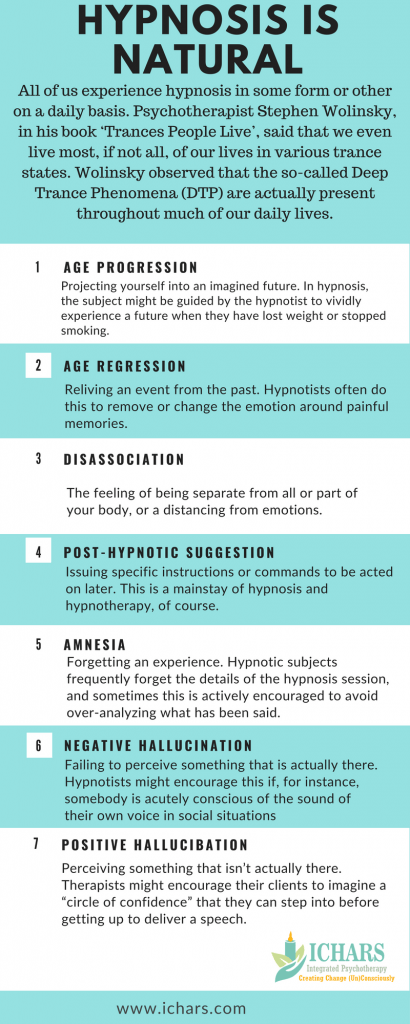The term “deep trance” is used to refer to a number of altered states that are characterized by profound relaxation and loss of control over the body, as well as a subjective sense of floating or detachment from one’s physical self.
Deep Trance Phenomena (DTP), generally believed to be exclusively part of formal hypnotherapy sessions, are actually present throughout much of our daily lives. “Normal” consciousness, he argued, is made up of these phenomena, which we switch into and out of all day long.
Examples of Deep Trance Phenomena

The following is a list, together with examples of how this phenomena might be encountered in everyday life.
- Age Progression
Projecting yourself into an imagined future.During Hypnotherapy sessions, the subject might be guided by the hypnotherapist to vividly experience a future when they have lost weight or quit drinking or have achieved any other outcome. In your day to day life, you age progress every time you are waiting for something, imagining what will happen next and how would things turn out, or when you see a dress in a shop and picture how would this dress look when you are wearing it.
- Age Regression
Reliving an event from the past.Hypnotists often do this to remove or change the emotion around painful memories.You age regress in your daily life every time you relive an argument that you had with someone even years ago.
- Disassociation
A feeling of being separate from all or part of your body, or a distancing from emotions.Hypnotic subjects often say that they can’t feel their arms or legs, and this can be a useful tool for pain control.In your day to day life, you’re emotionally disassociated when you logically know what you should be feeling in an event but are not able to experience that feeling emotionally.
- Post-Hypnotic Suggestion
Issuing specific instructions or commands to be acted on later.
This is the basis of hypnosis and hypnotherapy. A hypnotherapist will use suggestions like “notice yourself experiencing a deep sense of confidence as you stand on the stage”.
It also happens when you find yourself thinking “I really must call my boss”, “remember to withdraw money from the ATM on my way home” and so on.
- Amnesia
Forgetting an experience.
Hypnotic subjects frequently forget the details of the hypnosis session, and sometimes this is actively encouraged to avoid over-analyzing what has been said.
You experience amnesia every time you can’t remember where you left your car keys, wallet or mobile phone.
- Negative Hallucination
Failing to perceive something that is actually there.
Hypnotists might encourage this if, for instance, somebody is acutely conscious of the sound of their own voice in social situations.
An everyday example would be failing to see your car keys, wallet or mobile phone as you frantically search for them, even though they’re in plain view on top of the kitchen counter.
- Positive Hallucination
Perceiving something that isn’t actually there.
Therapists might encourage their clients to imagine a “circle of confidence” that they can step into before getting up to deliver a speech.
If you’ve ever had a fantasy or daydream about someone, then you’ve positively hallucinated. This is quite closely associated with age progression as well, of course.
- Confusion
This is often deliberately employed as a trance-inducing technique, and we all experience moments of bewilderment, perhaps at those times when you wander into a different room of the house and wonder what you’re doing there.
- Time Distortion
A sense of time slowing down or speeding up.
This is a major feature of hypnotic trance, and subjects often feel that more time has passed than is actually the case.
You experience time distortion in traffic jams and boring meetings, which seem to last forever, and also on those occasions when you’re really enjoying yourself and time just seems to fly by.
- Sensory Distortion
Increasing or decreasing sensory awareness.
During hypnotherapy sessions, the hypnotherapist might draw the client’s attention to various bodily sensations, as a way of inducing and deepening trance.
Sensory distortion is also evident at those times when you manage to tune out a persistent noise – people who live near railway lines, for instance, simply don’t notice the passing trains after a while.
Wolinsky became fascinated by the role these phenomena play in keeping problems in place. In a typical case of anxiety, for instance, we might see age progression and positive hallucination, as the sufferer conjures up a terrible future and sees signs of imminent catastrophe. We might also see sensory distortion, as anxiety sufferers are often acutely aware of unpleasant sensations in their body, such as heart palpitations, which further fuel the anxiety.
Identifying the deep trance phenomena behind a problem points the way to a solution, as that trance state can be changed or broken. This raises the interesting possibility that hypnosis works by bringing people out of unhelpful trance states – unhypnotizing them, in effect!
If you would like to learn how to use hypnosis for helping clients experiencing deep trance phenomena and using the same to help them resolve their problems ad achieve their desired outcome, then check out the Cognitive Hypnotic Psychotherapy Diploma

